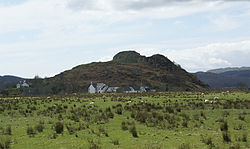Difference between revisions of "Dunadd"
(Created page with "{{Infobox castle |name=Dunadd Hillfort |county=Argyll |picture=Dunadd Fort 20080427.jpg |picture caption=Dunadd Hillfort Crag |os grid ref=NR836936 |latitude=56.086111 |longit...") |
(No difference)
|
Latest revision as of 18:34, 28 March 2022
| Dunadd Hillfort | |
|
Argyllshire | |
|---|---|
 Dunadd Hillfort Crag | |
| Type: | Hill fort |
| Location | |
| Grid reference: | NR836936 |
| Location: | 56°5’10"N, 5°28’43"W |
| History | |
| Information | |
| Condition: | Ruin |
| Owned by: | Historic Scotland |
Dunadd is a famous hillfort in Argyllshire dating from the Iron Age and the early Middle Ages, and which and is believed to be have been the capital of the ancient kingdom of Dalriada, also rendered 'Dál Riata'.[1][2] The Kingdom of Dalriada appeared in Argyll in the early centuries AD, possibly after the Romans had abandoned Southern Britain and left the Britons undefended against barbarians seeking land and plunder in the rich lands of the island – Picts from the Highands, Saxons from across the sea, and Scots from Ireland. The very name of Argyll derives from this settlement as the 'Borderland of the Gael'.
The name given to the place today, Dunadd, is from the Gaelic Dún Ad, meaning 'Fort on the [River] Add'.
Contents
Description
Dunadd is a rocky crag that may have been one time an island and now lies inland near the River Add, from which it takes its name, a little north of Lochgilphead. The surrounding land, now largely reclaimed, was formerly boggy and known as the Mòine Mhòr ("Great Moor") in Gaelic. This no doubt increased the defensive potential of the site.[3] Detailed analysis of sea-level changes in the region argue that the Dun was an island or promontory into historic times, and that receding sea levels left the fortification open to siege and seizure in the 6th to 7th centuries[4]
History
Originally occupied in the Iron Age, the site later became a seat of the kings of Dál Riata. It is known for its unique stone carvings below the upper enclosure, including a footprint and basin thought to have formed part of Dál Riata's coronation ritual. On the same flat outcrop of rock is an incised boar in Pictish style, and an inscription in the ogham script. The inscription is read as referring to a Finn Manach and is dated to the late 8th century or after.
Dunadd is mentioned twice in early sources. In 683 the Annals of Ulster record: "The siege of Dún At and the siege of Dún Duirn" without further comment on the outcome or participants. In the same chronicle the entry for 736 states: "Aengus son of Fergus, king of the Picts, laid waste the territory of Dál Riata and seized Dún At and burned Creic and bound in chains two sons of Selbach, Donngal and Feradach."[5]
The site was occupied after 736, at least into the 9th century. It is mentioned twice in later sources, suggesting that it retained some importance. In 1436, it is recorded that "Alan son of John Riabhach MacLachlan of Dunadd" was made seneschal of the lands of Glassary; the chief place of residence of the MacLachlans of Dunadd lay below the fort. In June 1506, commissioners appointed by James IV, including the earl and bishop of Argyll, met at Dunadd to collect rents and resolve feuds.
The site is an Ancient Monument, under the care of Historic Scotland, and is open to the public.[6]
Excavations
Because Dunadd is mentioned in early sources, and is readily identifiable, it has been excavated on several occasions (1904–1905, 1929, and 1980) and has one of the most important ensembles of finds from any early mediæval site in the north. Finds range from the 6th to the 8th centuries AD. These include tools, weapons, quernstones, imported pottery and motif-pieces and moulds for the manufacture of fine metalwork (especially jewellery).
Bruach An Druimein Connection
Four miles north of Dunadd is the site of Bruach An Druimein. Excavated in the 1960s in advance of gravel quarrying, archaeologists discovered the remains of a Bronze Age cists cemetery, two round houses from the Iron Age, and a number of artefacts from the early mediæval period that were contemporary with Dunadd. Two mediæval glass beads were found that have similar chemical compositions to those found at Dunadd, leading the archaeologists to believe that the beads came from Dunadd and that the site was associated with, or controlled by Dunadd.[7]
In fiction
In Rosemary Sutcliff's 1965 novel The Mark of the Horse Lord the Dalriadans undergo an internal struggle for control of royal succession, with Dun Monaidh central to the conflict, including a depiction of royal coronation and use of a carved footprint. Dunadd is the location for Claire R. McDougall's novel "Veil of Time," in which a modern-day woman is transported back to Dunadd's heyday in the 8th century. All the features of Dunadd, including the footprint, the boar, the well and the tumble down ruins are features of the story, as are the modern farm and cottages . Other ancient sites in the Kilmartin Valley also play a part in the narrative.
Pictures
Outside links
| ("Wikimedia Commons" has material about Dunadd) |
- The Kingdom of the Gaels, BBC Scotland - Scotland's History
References
- ↑ John Keay and Julia Keay, Collins Encyclopedia of Scotland, (Harper Collins, 1994) p. 255.
- ↑ Kilmartin Glen: Dunadd Fort
- ↑ Lane, Alan and Campbell, Ewan: 'Dunadd: An early Dalriadic capital' (Oxbow Books, 2000)
- ↑ Lathe, Richard; Smith, David, "Holocene Relative Sea-Level Changes in Western Scotland: The Early Insular Situation of Dun Add (Kintyre) and Dumbarton Rock (Strathclyde)", The Heroic Age 16: 1–5, http://www.heroicage.org/issues/16/lathe_smith.php
- ↑ The Annals of Ulster
- ↑ Kilmartin Glen Dunadd Fort: Historic Scotland
- ↑ "Vol 27 (2008): Bruach An Druimein, Poltalloch, Argyll: excavations directed by the late Eric Cregeen, 1960-2 | Scottish Archaeological Internet Reports". http://journals.socantscot.org/index.php/sair/issue/view/47.









